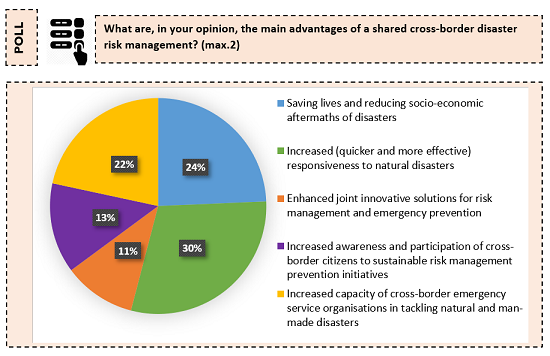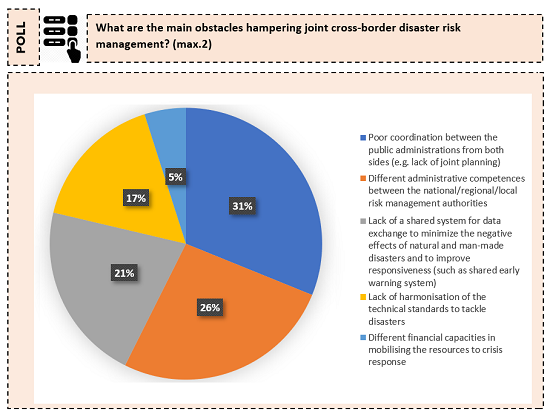The event was opened by Ms Myriam Boveda, from the Smart and Sustainable Growth Unit, DG REGIO, who stated that the European Commission has acknowledged the need to operate beyond national borders to enhance the preparedness and response, also in the framework of the EU Green Deal. Border regions play a major role in integrating elements of the EU Green Deal into Cohesion Policy programmes, which can also be used as an opportunity to formulate pathways for the long-term sustainable transition. To do so, DG REGIO has published a toolkit to support national and regional authorities in introducing the necessary systemic changes through cohesion policy. It is important that these investments are targeted towards the transition to a more resilient environment, including regions’ prevention and preparedness, with the aim of improving cooperation mechanisms among regions facing the same risks from the same natural resources. A cross-border approach means joint monitoring and planning, alignment of climate change adaptation strategies, and prevention management of cross border rivers, woods, coastlines but also technologies and assets.
The event also provided an opportunity for participants to express their opinions on the topic. The first poll results showed that there are several advantages stemming from cross-border cooperation in dealing with disaster risk management which were perceived as equally important. They highlighted that cross-border disaster risk management increases responsiveness, it helps save lives and reduces socio-economic consequences in the aftermath of an event. Furthermore, cooperation increases capacity in tackling natural and man-made disasters, improves awareness and participation of citizens in border regions in sustainable risk management prevention initiatives, and enhances joint innovative solutions for the risk management and emergency prevention.

Evidence from the territories
First experience: Romania-Bulgaria
Who: Head of Unit, Managing Authority for Interreg V-A |
The first intervention was made by Ms Marcela Glodeanu, Head of Unit of the Managing Authority of the Interreg Programme Romania-Bulgaria. The programme area is characterised by a long border marked almost entirely by the Danube River which, together with its tributaries, makes the area particularly exposed to floodings. Other risks are related to wildfires and earthquakes as well as man-made technological risks, due to the presence of nuclear plants along the border area. Since the cooperation started in 2007, several of their projects addressed risk prevention, with the objective of creating a framework that regulates cross-border intervention in case of disasters. Moreover, the programme also aims to increase civil society awareness: the JEROME project enhances first-responders’ awareness and equip them to safely intervene in case of chemical, biological, radiological or nuclear disasters.
Second experience: Italy-Slovenia
Who: Civil protection project representative, Interreg Italy- Slovenia V-A |
The second voice from the territory was Mr Aldo Primiero, from the regional civil protection department of Friuli Venezia Giulia Region. He presented the CROSSIT SAFER project, which enhances cooperation between public authorities and civil protection organisations in managing natural risks related to the geomorphological characteristics of the territory, mainly causing floodings and earthquakes. The project also builds capacity and enforces cooperation with a wider and more immediate approach both in preparedness and response. To do so, the project designed shared protocols and harmonised procedures, disseminated through educational and practical training activities.
Both speakers reported that their activities were welcomed and appreciated by schools and the general population. In the case of the CROSSIT SAFER project, these exercises are important especially when dealing with small events which are more frequent, and are thus very close to people’s first-hand experiences.
Following both presentations, the participants were invited to answer a poll about the main obstacles hampering joint cross-border disaster risk management. The visual below shows that poor coordination between the public administration from both sides is perceived as the main obstacle, followed closely the by different administrative competences between the different levels of risk management authorities and lack of a shared system for data exchange. Lack of harmonisation of the technical standards to tackle disasters was perceived as a barrier, but to a minor degree, while different financial capacities in mobilising the resources to crisis response was not really considered a major issue.

Panel discussion
The panel discussion opened with the intervention of Mr Ignacio Sanchez Amor, Member of the European Parliament from the group of the Progressive Alliance of Socialists and Democrats, who stressed the link between border regions being less populated and the consequent lack of resources to deal with disaster events, compared to bigger cities or coastlines. This gap could be bridged by pooling resources and skills across borders, starting with an assessment of the resources available and how they can be accessed at a cross-border level. This would require further coordination among institutions and organisations that do not have the same competences. In fact, different competences together with heavy bureaucratic requirements can hamper the realisation of a really coordinated response because of hierarchical barriers among institutions. Procedures should be created so as to remove this additional layer of difficulty, especially in emergency situations. On the other hand, more technical issues can be overcome easily with political will from both sides and with priorly established procedures.
The floor went then to Ms Ángela Iglesias Rodrigo, Head of the Department of Defence Against Forest Fires, from the Spanish Ministry for the Ecological Transition and the Demographic Challenge. She agreed with Mr Amor that clear chains of command with common protocols and procedures should be defined in advance to facilitate quick response and action. In the cross-border case of Spain and Portugal, this obstacle was successfully overcome with the appointment of a liaison officer in each country. These two officers have the knowledge and skills to act as a bridge between the country’s different bodies responsible for wildfire management and response. She also stressed the importance of harmonising procedures, rather than standardising them. This is true at cross-border level but is mostly primarely need at national level (due to different competences at the regional level, the approach is not sometimes not even homogenous within the same country). She also agreed with Mr Primiero and the need to focus on smaller, more targeted exercises to increase effectiveness and preparedness, involving the right institutions having responsibilities in that field.
The answers from the polls were also highligted during the panel debate, showing that both civil society and experts in the field share the same views on the topic. Some interesting suggestions to increase cross-border disaster risk management which emerged from the event were summarised by Ms Myriam Boveda’s final remarks:
- There is an increasing need for enhanced coordination in dealing with natural disasters which, due to climate change, are more extreme and more frequent.
- Better prevention and better responsiveness are two sides of the same coin. In fact, the better prepared and the more prevention measures are in place, the more effective the response is.
- The available means to increase this coordination are:
- the improvement of technological tools,
- greater participation and engagement of a wider range of stakeholders,
- smaller and more targeted exercises
- the appointment of representatives with the skills to bridge the hierarchical gap between different countries’ bodies.
Finally, she mentioned language barriers which, unlike in many other situations, are not so strongly felt in emergencies. It’s rather the opposite: when in crisis, we all speak the same language.
Watch again
If you could not join us for this event or if you want to watch it again, the recording is available here.